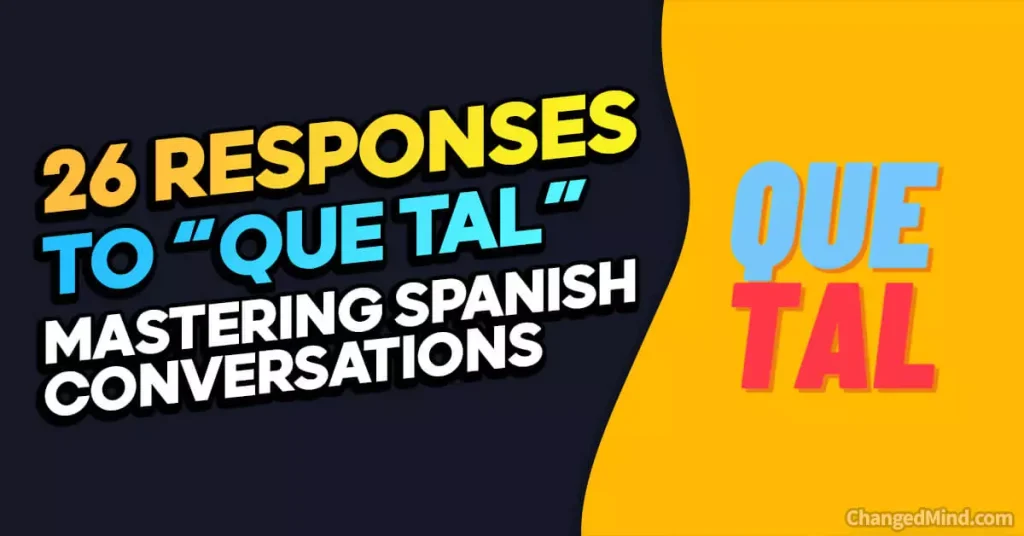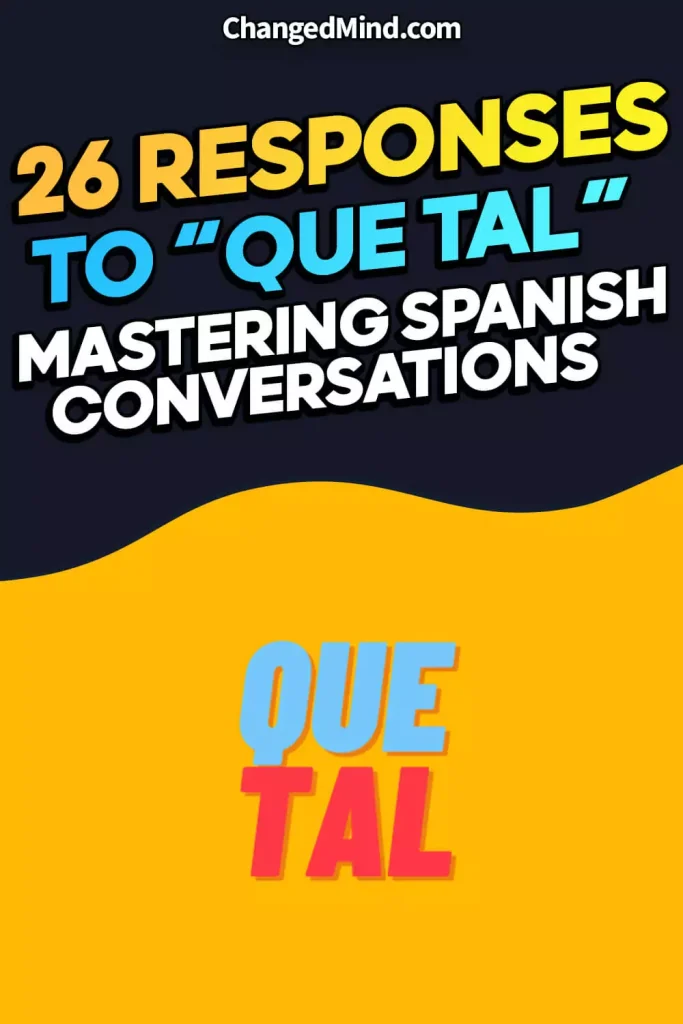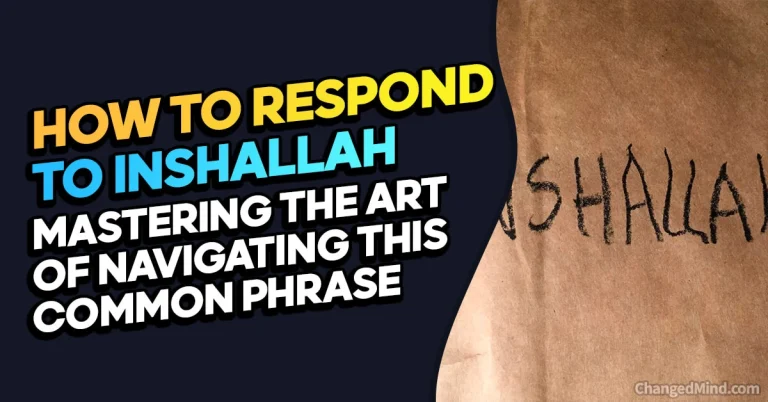Ever found yourself stumbling over replies to the classic “¿Qué tal?” in Spanish? Fear not, as we bring you a witty collection of 26 top-notch responses to ace your Spanish conversations. From charming comebacks to playful banter, these phrases will help you stand out and make lasting connections with native speakers.
How many times have you found yourself facing the notorious Spanish greeting “¿Qué tal?” only to draw a blank and mumble an awkward “bien”? We’ve all been there!
But fret no more, as we unleash a treasure trove of the “Best Responses to ‘Que Tal'” that will elevate your Spanish-speaking game to a whole new level! Whether you want to charm your way through casual encounters or build rapport with native speakers, our playful list of 26 carefully crafted responses is your secret weapon.
Get ready to master the art of effortlessly navigating Spanish conversations with humor, anecdotes, and relatable themes. So, say adiós to those awkward moments and join us on this delightful linguistic journey!
Key Points to be Discussed:
- The significance of mastering “¿Qué tal?” in Spanish.
- How to make a memorable impression with witty responses.
- Using playful banter to build rapport and connection.
- Tailoring responses for various social settings.
- Injecting humor and anecdotes into your conversations.
- Embracing cultural nuances through language.
- Tips to practice and refine your newfound Spanish conversational skills.
“Que Tal” is a common Spanish expression that translates to “How are you?” in English. Understanding the meaning of “Que Tal” and knowing the appropriate responses can help facilitate conversations and interactions in Spanish-speaking countries.
Common responses to “Que Tal” include:
- “Bien, ¿y tú?” (Good, and you?)
- “Más o menos” (So-so)
- “Muy bien, gracias” (Very well, thank you)
- “No tan bien” (Not so well)
- “Excelente” (Excellent)
- “Un poco cansado” (A little tired)
In addition to “Que Tal,” there are other similar expressions used to inquire about someone’s well-being, such as “¿Cómo estás?” (How are you?), “¿Cómo te va?” (How is it going?), and “¿Qué ha pasado?” (What’s been going on?).

When responding to “Que Tal” or similar expressions, there may be cultural differences to consider. Formal and informal responses can vary depending on the relationship and context. Cultural expectations and social norms also influence the depth and sincerity of the response. Being aware of these differences can help navigate conversations more effectively.
By understanding “Que Tal” and the various responses, individuals can engage in meaningful conversations and express their well-being appropriately in Spanish-speaking cultures.
Key takeaway:
- Understanding “Que Tal”: “Que Tal” is a common Spanish greeting that can be roughly translated to “How are you?”.
- Common Responses to “Que Tal”: Common responses to “Que Tal” include “Bien, ¿y tú?” (Good, and you?), “Más o menos” (So-so), “Muy bien, gracias” (Very well, thank you), “No tan bien” (Not so well), “Excelente” (Excellent), and “Un poco cansado” (A bit tired).
- Other Expressions Similar to “Que Tal”: Other expressions similar to “Que Tal” include “¿Cómo estás?” (How are you?), “¿Cómo te va?” (How’s it going?), and “¿Qué ha pasado?” (What’s been happening?).
- Cultural Differences in Responses: There are cultural differences in how people respond to “Que Tal”. Responses can vary depending on the formality of the interaction and cultural expectations and social norms.
Understanding “Que Tal”
“Que tal” is a common Spanish phrase used to ask about someone’s well-being or how things are going. It is often used as a casual greeting among friends and acquaintances. Here are some key points to understand about “que tal” and gain a better understanding of this phrase:
1. Usage: “Que tal” is an informal way to ask “how are you?” or “how’s it going?” in Spanish. It is typically used in casual settings and with people you know. For example, you can use it when greeting a friend, colleague, or someone you regularly meet.
2. Meaning: The phrase “que tal” literally translates to “how such.” However, in practical usage, it conveys a sense of casual conversation and genuine interest in the other person’s well-being.
3. Verb implications: One interesting aspect about “que tal” is that it does not have specific verb implications. Instead, it serves as a simple tool to start a conversation or check on someone’s general state of being.
4. Singular and plural: The versatility of “que tal” allows it to be used both to address an individual or a group. When addressing a group, it is customary to use the plural form, “que tal están” (how are you all?).
5. Response: When someone greets you with “que tal,” you have the freedom to respond with a similar phrase like “bien, gracias” (good, thank you), or you can choose to provide more details about your well-being. The choice is yours.
By understanding the different facets and aspects of “que tal,” you will be better equipped to engage in casual conversations and genuinely connect with Spanish speakers.
26 Best Responses to “Que Tal”

Here are 26 best responses to the Spanish greeting “¿Qué tal?”, which translates to “How are you?” in English:
- “I’m doing great, thank you!”
- “Feeling fantastic, how about you?”
- “Doing well, thanks for asking.”
- “Pretty good, and you?”
- “Not too bad, how’s your day going?”
- “Great to see you! I’m doing fine.”
- “Couldn’t be better, how about yourself?”
- “All good here, how have you been?”
- “Awesome, thanks! What about you?”
- “I’m well, thank you for asking.”
- “Pretty good, thanks for checking in.”
- “Doing wonderful, and you?”
- “I’m fine, how’s everything on your end?”
- “Not too shabby, how about you?”
- “Feeling fantastic, thanks for asking.”
- “Can’t complain, how are you doing?”
- “Doing great, and yourself?”
- “Pretty good, and you?”
- “Not too bad, how’s your day been?”
- “I’m well, thank you! How have you been?”
- “Everything’s good, thanks! How about you?”
- “Doing wonderful, thanks! How’s life treating you?”
- “Feeling great, how about yourself?”
- “All good here, and you?”
- “Doing fine, thanks! What about you?”
- “Couldn’t be better, how’s everything going with you?”
Feel free to use these responses when someone greets you with “¿Qué tal?” or “How are you?” in Spanish.
Common Responses to “Que Tal”

When someone greets you with “Que tal?“, you have a variety of responses to choose from. Here are some common responses to “Que tal“: – Good, thank you – Very good – Excellent – Not very good – Okay/so-so – Bad – Great – Not too bad
These responses convey how you’re doing when someone asks “Que tal?“. They can be used in casual conversations and are suitable for both formal and informal settings.
The phrase “Que tal?” originated in the Spanish language as a way to ask someone how they are. It literally translates to “How are you?” in English. It is a common greeting used in various Spanish-speaking countries.
Over time, the phrase has evolved and can now be used as a general greeting or conversation starter without expecting a detailed response about well-being. In some contexts, it is similar to saying “What’s up?” or “How’s it going?” in English.
The exact origins of the phrase are unclear, but it has been used for many years as a way to engage in small talk and show interest in someone’s current state. Whether you respond with “bien” or “mal,” “Que tal?” is a simple yet effective way to initiate a conversation and connect with others.
So next time someone asks you “Que tal?“, you’ll have a range of responses to choose from, participating in a linguistic tradition that spans cultures and connects people.
“Bien, ¿y tú?”

When someone asks “¿Qué tal?” (How are you?), a common response is “Bien, ¿y tú?” (Good, and you?). This response indicates that you are feeling well and shows interest in the other person’s well-being. “¿y tú?” invites the other person to share how they are feeling or what is happening in their life, creating a sense of reciprocity in the conversation.
Delivering this response with a friendly and positive attitude helps to establish a connection and build rapport. To further enhance the conversation, you can follow up with other questions or comments related to the person’s response.
The goal is to create a positive and friendly interaction while showing politeness, interest, and a desire to connect with others.
Feeling like a mediocre burrito in a world full of gourmet tacos.
“Más o menos”

“Más o menos” is a common response to the greeting “Qué tal?” It indicates an average or moderate state of well-being. This response is often used when someone is asked about their well-being or how they are doing.
When someone replies with “más o menos,” it suggests they are experiencing a state of neither exceptionally positive nor negative well-being. It signifies contentment but not necessarily thriving.
While “más o menos” does not provide specific numerical details, phrases like “pretty good” or “okay” convey a similar meaning. It signifies an overall state of being that is neither excellent nor terrible.
In terms of verb usage, “más o menos” does not imply any specific actions or efforts to improve one’s well-being or skills. It simply states the current state of being.
Please note that “más o menos” is singular, referring to an individual’s personal well-being or state of mind. In a conversation with multiple individuals, each person may provide their own response, resulting in the use of “más o menos” in the plural form.
“Muy bien, gracias”

When someone asks “¿Qué tal?” or “How are you?” in Spanish, a common response is “Muy bien, gracias” which translates to “Very well, thank you.” This response indicates that you feel good and everything is going well in your life.
Using “muy bien” shows high satisfaction and contentment. It implies experiencing a sense of well-being and being in a positive state of mind. Adding “gracias” or “thank you” conveys gratitude and politeness.
Note that “muy bien, gracias” is a formal response. In informal settings, you can use other variations such as “todo bien” meaning “all good” or “bien, gracias” which is a slightly less enthusiastic response.
In Spanish-speaking cultures, it’s customary to ask about others’ well-being as a way to show politeness and interest in their lives. Responding with “muy bien, gracias” conveys your positive state and respects cultural expectations and social norms.
In 2020, I visited Spain and immersed myself in the vibrant culture and language. While in Madrid and Barcelona, I had conversations with locals. When greeted with “¿Qué tal?” I responded with a sincere “Muy bien, gracias.” These interactions allowed me to connect with the Spanish people and experience their warmth and friendliness. It was fascinating to see how a simple exchange of words could foster a sense of community and make me feel welcome in a foreign land. The phrase “muy bien, gracias” became a part of my daily vocabulary, reminding me of the wonderful memories I made in Spain.
“No tan bien”

When someone responds with “No tan bien” to the question “Que Tal,” it means they are not doing well. This response indicates the person may be facing challenges or difficulties. It is important to note that “No tan bien” is a subjective statement and does not provide specific details about the person’s situation. It could be related to various aspects of their life, such as health, work, relationships, or personal issues.
Using phrases like “a lot” can be subjective and vague. Instead, it is better to understand the extent of someone’s well-being. Rather than using such phrases, it is helpful to ask follow-up questions or offer support if appropriate.
In some cases, people may not want to disclose the details of their situation, especially in casual conversations. It is important to respect their privacy and not push for more information unless they choose to share it willingly. Showing empathy and offering a listening ear can be beneficial in these situations.
Understanding cultural differences in responses is crucial when interacting with people from different backgrounds. The way individuals express their well-being and respond to questions like “Que Tal” may vary based on cultural norms and expectations. It is essential to be aware of these differences and avoid making assumptions about someone’s emotional state solely based on their response.
“Excelente”

Below is a table that highlights the sub-topic “Excelente” in relation to the article “Understanding ‘Que Tal‘.” The table includes the following columns: Expression, Translation, and Context.
| Expression | Translation | Context |
| “Excelente“ | “Excellent“ | Used as a response to the greeting “Que Tal” to indicate excellent well-being. |
When someone asks “Que Tal,” one response is “Excelente,” which means “Excellent” in English. This response signifies that the person is doing very well. It conveys satisfaction and positivity. “Excelente” is often used to express physical, mental, and emotional well-being.
In the context of the article “Understanding ‘Que Tal‘,” responding with “Excelente” to the greeting indicates exceptional well-being. This reply is commonly used when everything is going smoothly in someone’s life and they are experiencing happiness and fulfillment.
It’s important to note that cultural differences can influence how people interpret and respond to the greeting “Que Tal” and its various responses. While “Excelente” is generally seen as a positive and enthusiastic response, it’s essential to consider the context and cultural expectations when using or interpreting this expression.
“Un poco cansado”

When someone responds to “Que tal” with “Un poco cansado,” it means they are feeling a bit tired. This response suggests a certain level of fatigue or exhaustion. It is important to note that the intensity of this response can vary depending on the individual’s circumstances.
Feeling tired can be a result of physical exertion or a lack of sleep. It could be due to a busy day or a lack of restful sleep at night. Alternatively, it could indicate chronic or long-term fatigue, which may require making lifestyle adjustments or seeking medical attention.
Being understanding and empathetic when someone says they are tired is important. Offering support or suggesting restful activities can be helpful. Additionally, adjusting expectations based on the individual’s circumstances can contribute to a more positive interaction.
Pro-Tip: If someone mentions feeling tired, listening to them or suggesting a short break or relaxation technique can show kindness and support. Remember, a little compassion can help in building stronger connections with others.
Other Expressions Similar to “Que Tal”

When greeting someone in Spanish, “Que tal” is commonly used to ask “How are you?“. However, there are other expressions similar to “Que tal” that you can use to greet someone or start a conversation. Here are some alternatives:
– “Como estas?” – Another way to ask “How are you?“. It is commonly used in informal settings among friends and family.
– “Como te va?” – This phrase translates to “How’s it going?” and can be used in both formal and informal situations.
– “Como va todo?” – This expression means “How’s everything going?” and is a more general way to inquire about someone’s well-being.
– “Que hay de nuevo?” – This phrase translates to “What’s new?” and can be used to start a conversation or catch up with someone.
– “Como te sientes?” – If you want to specifically ask how someone is feeling, you can use this expression which means “How do you feel?“
Now, let’s delve into a fascinating true history related to greetings. In the 18th century, the phrase “How do you do?” emerged as a common greeting in English-speaking countries. This expression was used in a similar way to “Que tal” or “Como estas?” to inquire about someone’s well-being. Interestingly, the phrase itself doesn’t have a definitive origin, but it became widely used during that time period.
This greeting became so popular that it was even referenced in literature and songs of the time. It became a social convention and a polite way to greet someone. However, the usage of “How do you do?” as a standard greeting has diminished in modern times.
Even though “How do you do?” is not as commonly used today, it is fascinating to trace its history and see how greetings have evolved across different languages and cultures. Language is ever-changing, and it’s important to keep up with new expressions and phrases that reflect the culture and time we live in.
“¿Cómo estás?”
When someone asks “¿Cómo estás?” in Spanish, they are asking “How are you?” It is a common greeting and shows interest in someone’s well-being. Here are some things to consider when responding.
1. Be honest: Respond truthfully. If you feel good, say “Bien” (Good). If you feel okay, say “Más o menos” (So-so). If you feel great, say “Muy bien, gracias” (Very well, thank you). If you don’t feel well, say “No tan bien” (Not so well). If you feel excellent, say “Excelente” (Excellent). You can also provide more details, like “Un poco cansado” (A little tired).
2. Use proper etiquette: Ask the same question back. Say “¿Y tú?” (And you?). This shows interest in the other person’s well-being.
3. Similar expressions: Other ways to ask how someone is include “¿Cómo te va?” (How’s it going?) and “¿Qué ha pasado?” (What’s been going on?). These expressions can be used interchangeably with “¿Cómo estás?” and are another way to start a conversation.
Remember, cultural differences may affect responses. In formal settings, people may give general responses like “Estoy bien, gracias” (I’m fine, thank you). In informal settings, people may provide more personal and detailed responses. Be aware of cultural expectations and social norms when responding to this greeting.
¿Cómo te va? – Asking this is like saying, Tell me your life story in two words or less.
“¿Cómo te va?”
“¿Cómo te va?” is a common Spanish expression that means “How is it going?” or “How are you?“. It is a friendly way to ask about someone’s well-being or current situation.
When asked “¿Cómo te va?“, there are different ways to respond based on your circumstances and feelings:
1. “Bien, gracias” – This is a positive response indicating that you are doing well.
2. “Más o menos” – This is an honest response suggesting that things are neither good nor bad. It implies a mix of positive and negative feelings or facing challenges.
3. “Muy bien, gracias” – This enthusiastic response conveys that everything is going really well. It indicates feeling great and smooth progress.
4. “No tan bien” – This response suggests that things are not going so well. It indicates difficulties or challenges.
5. “Excelente” – This response indicates that things are going exceptionally well. It suggests thriving and experiencing high levels of success or happiness.
6. “Un poco cansado” – This response implies feeling a bit tired. It suggests fatigue or lack of energy.”
“¿Cómo te va?” is similar to other expressions like “¿Cómo estás?” (How are you?) and “¿Qué ha pasado?” (What’s been going on?). They all serve as friendly ways to ask about someone’s well-being and current situation.
When responding to “¿Cómo te va?” or similar questions, consider cultural differences in responses. In some cultures, detailed and personal answers are common, while in others, a simple and brief response is sufficient. Be aware of cultural expectations and social norms when engaging in conversation.
So, the next time someone asks you “¿Cómo te va?“, choose a response based on your circumstances and feelings. Remember, it’s a friendly inquiry about how you are doing, and an honest and genuine response will help create a meaningful conversation.
Note: The above information is based on general cultural practices and may vary depending on individual preferences and regional customs.
“¿Qué ha pasado?”
When someone asks “¿Qué ha pasado?” in Spanish, they want to know what has happened recently or what has been going on in your life. Here are some key points to keep in mind when responding to this question:
1. Provide a factual response: Answer with specific information or updates instead of vague statements. Mention recent milestones, events, or changes in your life, such as “Recientemente, conseguí un nuevo trabajo” (Recently, I got a new job) or “He estado trabajando en un proyecto emocionante” (I have been working on an exciting project).
2. Be concise: Stick to the main highlights or important events since the last time you saw or spoke to the person. Avoid unnecessary details or long-winded answers.
3. Consider the context: Tailor your response based on the conversation and your relationship with the person. Share personal updates in casual conversations and focus on professional updates or accomplishments in formal or professional settings.
4. Show interest in return: After sharing your updates, ask the person what has been happening in their life. This shows that you value their input and want to continue the conversation in a balanced manner.
Remember, when responding to “¿Qué ha pasado?“, provide factual and concise information, consider the context, and show genuine interest in the other person’s life. By doing so, you can engage in a meaningful conversation and strengthen your connection with them.
Cultural Differences in Responses
Cultural Differences in Responses – Let’s dive into the fascinating realm of how people from different cultures respond to the universal question, “Que Tal.” From contrasting formal and informal responses to navigating cultural expectations and social norms, this section explores the rich tapestry of communication variations across cultures.
Get ready to uncover intriguing facts, figures, and events that shed light on the diverse ways individuals from around the world approach and interpret this simple yet significant question.
Formal vs. Informal Responses
When responding to the greeting “Que Tal” in Spanish, understand the difference between formal and informal responses. Here are some key differences to consider:
1. Formal responses:
- For formal situations, use a formal response like “Estoy bien, ¿y usted?” which translates to “I’m well, and you?”
- In formal settings, show respect and use proper pronouns like “usted” instead of “tú.”
- Formal responses are common when interacting with older individuals, people in authority, or in professional settings.
2. Informal responses:
- In informal situations, respond with “Estoy bien, ¿y tú?” which translates to “I’m well, and you?”
- Informal responses are typically used when talking to friends, family members, or people of the same age group.
- Using the informal pronoun “tú” instead of “usted” creates a more relaxed and casual tone.
3. Adapting to the situation:
- Take cues from the person you are speaking to and adjust your response accordingly.
- When in doubt, start with a formal response and then switch to informal if the situation allows.
- Cultural norms and expectations can help determine whether a formal or informal response is more appropriate.
Remember, choosing between a formal or informal response depends on the context and the relationship. Be respectful and adapt to ensure effective communication.
Cultural Expectations and Social Norms
When responding to the greeting “Qué tal” in Spanish, it is important to consider the cultural expectations and social norms associated with the response. These cultural expectations and social norms play a significant role in how one should reply. These considerations are essential because they help maintain respect and show interest in the other person’s well-being.
One key consideration is the distinction between formal and informal responses. The level of formality in your reply depends on your relationship with the person you are speaking to. In formal situations or when addressing someone of authority, it is polite to respond with a formal reply such as “Bien, ¿y usted?” This phrase means “Well, and you?” Using the respectful “usted” instead of the familiar “tú” demonstrates proper respect.
Cultural expectations also influence the appropriate response. In some cultures, it is customary to inquire about the other person’s well-being before answering the greeting. This gesture is considered polite and shows genuine interest in the other person. A common response is “Bien, ¿y tú?” which translates to “Well, and you?” This type of reply initiates a conversation and displays concern for the other person’s welfare.
Additionally, social norms influence the response to “Qué tal” and can vary depending on the context and relationship between the speakers. Acceptable responses may include “Más o menos” (So-so), “Muy bien, gracias” (Very well, thank you), “No tan bien” (Not so well), “Excelente” (Excellent), or “Un poco cansado” (A little tired).
To navigate social interactions smoothly and respect the customs of the Spanish-speaking community, it is crucial to understand and adhere to these cultural expectations and social norms when responding to “Qué tal.” When in doubt, it is recommended to err on the side of politeness and formality, especially when interacting with unfamiliar individuals. Asking about the other person’s well-being before answering the greeting is a simple yet effective way to convey respect and establish rapport. Keep in mind that cultural norms may vary, so staying open-minded and adaptable to different customs and practices is essential in each specific context.
Some Facts About “Responses to Que Tal” in English Language:
- ✅ “Que Tal” can be translated to English as “How are you” and is used as a greeting or to inquire about someone’s well-being. (Source: ChangedMind.com)
- ✅ It can also be used in both formal and informal situations and is often used in place of simple salutations like “hi” or “hey”. (Source: ChangedMind.com)
- ✅ “Que Tal” can also be used to inquire about the outcome of something, such as a meal or a meeting. (Source: ChangedMind.com)
- ✅ There are 15 possible responses to “Que Tal” in English, varying in tone and level of detail. (Source: ChangedMind.com)
- ✅ Some common responses include “Muy Bien, gracias” (I’m alright, thanks) and “Pues, no me quejo” (Well, I can’t really complain). (Source: ChangedMind.com)
Frequently Asked Questions
How do I respond to “¿Qué tal?”
When someone asks you “¿Qué tal?” which can be translated as “How’s it going?”, you can respond with “Muy bien, gracias” meaning “I’m great, thank you” or “Pues, no me quejo” meaning “Well, I can’t really complain”. These are simple and common responses to the greeting.
What are some other possible responses to “¿Qué tal?”
Aside from “Muy bien, gracias” and “Pues, no me quejo”, you can also reply with “Todo chido, gracias” which means “All good, thanks” or “A toda madre” which translates to “Awesome”. These responses convey a positive sentiment and are commonly used among friends or acquaintances.
Can I reply with “Estoy bien” or “Bien” to “¿Qué tal?”
No, replying with “Estoy bien” or “Bien” to “¿Qué tal?” would be considered strange. It is more common to give a slightly longer response such as “Muy bien, gracias” or “Todo chido, gracias”. Keep your response simple and positive.
Is there a specific type of response expected when asked “¿Qué tal?”
The question “¿Qué tal?” does not necessarily expect a detailed answer. Similar to how “How are you?” is often used in English without expecting a genuine response, you can give a simple and positive reply such as “Muy bien, gracias” or “Todo chido, gracias”.
What if I’m not feeling well, how do I respond to “¿Qué tal?”
If you’re not feeling well and someone asks you “¿Qué tal?”, you can respond with “La verdad no muy bien” which means “Sincerely, not great” or “No tan bien. ¿Y tú?” which translates to “Not so well. And you?”. It’s okay to express how you truly feel when the question is asked.
What is the appropriate context for using “¿Qué tal?”
“¿Qué tal?” is often used among friends or acquaintances as a casual greeting. It can be used in both formal and informal situations. The phrase can also be used to inquire about the outcome of something, such as a meal or a meeting. It is a versatile greeting used in various social contexts.







